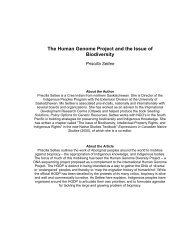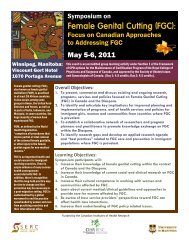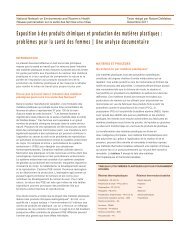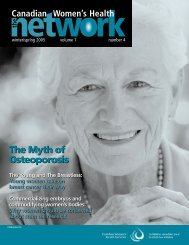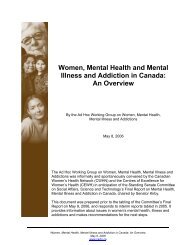exacerbate these problems. Those livingin rural areas also face additional challenges.In First Nations communities, only 70%of residents have telephones. In somecommunities, this is as low as 40%.Some American telephone companies offera “Lifeline” program providing lower ratesor a basic telephone service to low-incomepeople. <strong>Canadian</strong> telephone companiesoffer no such service. This is another areaw<strong>here</strong> health service providers could workwith community and consumer groups topromote change.4.2 UTILITY RATESIncreases in gas and electrical ratesdisproportionately affect those living onlow incomes, since they already spend agreater portion of their income onessential needs. Additionally, low-incomepeople tend to live in less well insulatedhousing, which is more expensive to heat.In Manitoba’s harsh climate, these arebasic health issues.Gas and electrical rates are set inManitoba by the Public Utilities Board(PUB), following applications by CentraGas and Manitoba Hydro. They followno set schedule.Manitoba Hydro has not applied for anyrate increases since 1996. The PUB doesnot at this point expect an application for ahydro rate increase.In the last year, gas prices increased andCentra Gas obtained a rate increase.Although gas prices are now beginningto decline from the high levels of 2001,interested health service providerscould work with consumers groupsand others to help make the connectionbetween utility rates and health.4.3 HOUSINGHousing costs are a major portion of thebudget of most households and housingitself is a factor which influences health.In recent years, the federal governmentand the past Manitoba provincialgovernment both withdrew support fornon-profit and co-operative housingprograms, thus leaving those on limitedincomes with few alternatives to the privatemarketplace.Housing conditions are a major issuefor Aboriginal people, both on and offreserves. The Assembly of ManitobaChiefs has reported that:Canada has a First Nationspopulation of approximately800,000 people, yet has onlyproduced 76,000 homes fromwhich this population must raisea family and build a community. 84In Manitoba, rents are regulated by theResidential Tenancies Branch (RTB) of theDepartment of Consumer and CorporateAffairs. The RTB annually sets a guideline,the maximum amount by which a landlordmay increase rent without approval fromthe RTB. For both 1999 and 2000, themaximum allowable rent increase ws set at1%. Landlords may apply to have rentsincreased above 1% if they have incurredadditional costs, for example, throughrepairs or renovations.For families living on social assistance, themaximum allowable rates for rent, as setby Manitoba Family Services (included inthe total social assistance rates shownabove), are as follows:Women, Income and<strong>Health</strong> in Manitoba54
Household Basic Rent Rent Including UtilitiesSingle person with disabilitySingle pregnant woman $243 $2852 people $285 $3873 people $310 $4304 people $351 $471Women, Income and<strong>Health</strong> in Manitoba55Prior to 1993, these rates were linked tothe maximum rental increase guidelinesset by the RTB. They were then de-linkedand t<strong>here</strong> has been no increase in theamount paid to social assistance recipientssince that time.These very low rates lead to increasedmobility, as families are forced to move tofind cheaper accommodation. As familiesmove, children may change schools inmid-year, and children and adults bothmay lose their connections with neighbourhoodsupports. The new, less expensivehousing may also be more crowded and/orless safe, which may further contribute toa deterioration in health status.T<strong>here</strong> are a number of ways in whichinterested organizations could interveneto heighten public awareness of the impactof housing conditions on health.In urban areas such as Winnipeg,community organizations may be ableto work with school divisions, andorganizations representing people withdisabilities, to raise awareness of theissue of shelter allowances for peopleliving on social assistance withprovincial decision-makers.It is also important to stress the largerissue of the need for affordable housing forall, and of the connection between goodhousing and good health.4.4 CHILD CAREHigh quality, affordable, accessible childcare programs are essential to the healthand well-being of children, their mothersand fathers. Much recent research hasfocussed on the benefits of early childhoodeducation to children and to society as awhole. (For example, the recent EarlyYears Report of the <strong>Canadian</strong> Institutefor Advanced Research 85 ).Less has been written about the impact ofthe gaps in the child care system on thehealth of women. Yet these are an obvioussource of stress for working mothers andfor those wishing to find employmentoutside of the home.According to the Manitoba Child CareAssociation (MCCA), child care in Manitobais underfunded. This underfundinghas led to a shortage of qualified staff, asthe mostly women employed in child careleave for better paying jobs. 86 As a result,approximately 25% of licensed Manitobachild care centres have receivedexemptions from the licensing requirementwhich stipulates the ratios of trained staff tochildren in centres. In response to theseconcerns, the Province of Manitobaincreased child day care funding by 18%,or $9.1 million, for the 2000-01 fiscal year.This additional funding is important to thechild care system, but several key issuesaffecting low-income women remain.These are:1. Cost of Child CareChild care costs in Manitoba, whilelower than those in other provinces,are significant. For parents of infants,the annual cost is $7,124 per year. Forthe parents of pre-school children,the annual cost is $4,794 per year.While the issue of the affordability ofuniversity tuition has had some publicprofile, the issue of the affordability
- Page 1 and 2:
WOMEN, INCOME ANDHEALTH IN MANITOBA
- Page 3 and 4: TABLE OF CONTENTSPageA. EXECUTIVE S
- Page 5 and 6: EXECUTIVE SUMMARYTHE LINK between p
- Page 7 and 8: Women, Income andHealth in Manitoba
- Page 9 and 10: B. INTRODUCTIONMuch work has been d
- Page 11 and 12: Consistent with the majority of soc
- Page 13 and 14: Health and Well-Being of Children i
- Page 15 and 16: Women, Income andHealth in Manitoba
- Page 17 and 18: members of different visible minori
- Page 19 and 20: Women, Income andHealth in Manitoba
- Page 21 and 22: 3. How has the connection between i
- Page 23 and 24: E. INCOME AND THE HEALTH OF WOMEN -
- Page 25 and 26: Women, Income andHealth in Manitoba
- Page 27 and 28: majority of British households,rega
- Page 29 and 30: Women, Income andHealth in Manitoba
- Page 31 and 32: The following chart, based on a cha
- Page 33 and 34: marsh potatoes, berries, etc. As a
- Page 35 and 36: opportunities for women may beone o
- Page 37 and 38: 2. Manitoba Data - Income and Healt
- Page 39 and 40: CHART 3HEALTH CARE EXPENDITURES ON
- Page 41 and 42: 3. What Does This Mean?As in other
- Page 43 and 44: procedures. It is noteworthy that t
- Page 45 and 46: 2. The Commonwealth Secretariat -Mo
- Page 47 and 48: Women, Income andHealth in Manitoba
- Page 49 and 50: H. MAKING PUBLIC POLICY HEALTHIER F
- Page 51 and 52: against women and its consequences
- Page 53: 3.3 CHILD TAX BENEFITThe Government
- Page 57 and 58: If RHAs are open to suchcollaborati
- Page 59 and 60: APPENDIX 1:SUGGESTIONS FOR FUTURE R
- Page 61 and 62: Women, Income andHealth in Manitoba
- Page 63 and 64: APPENDIX 3:HEALTH SERVICE UTILIZATI
- Page 65 and 66: APPENDIX 4:INTERVIEWS WITH ABORIGIN
- Page 67 and 68: Women, Income andHealth in Manitoba
- Page 69 and 70: Women, Income andHealth in Manitoba
- Page 71 and 72: Women, Income andHealth in Manitoba
- Page 73 and 74: ELEMENT #11GENDER SENSITIVE TRAININ
- Page 75 and 76: Women, Income andHealth in Manitoba
- Page 77 and 78: ENDNOTES1. Sarlo, Christopher, “P
- Page 79 and 80: ENDNOTES (continued)45. Arber, Sara
- Page 81 and 82: ENDNOTES (continued)88. Mustard, Ca
- Page 83 and 84: REFERENCES (continued)Clarke, H.F.
- Page 85 and 86: REFERENCES (continued)Macintyre, Sa
- Page 87 and 88: REFERENCES (continued)Vancouver/Ric





